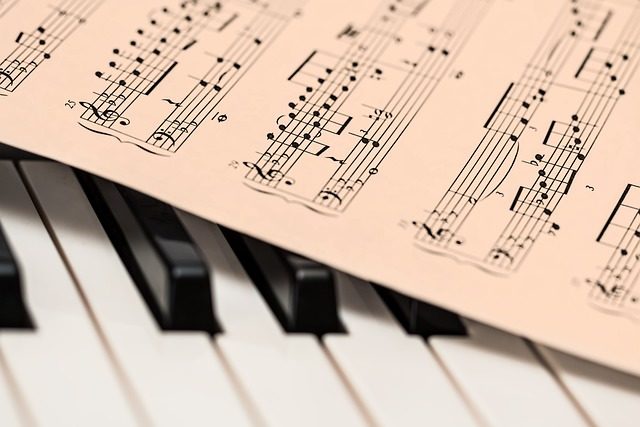Music theory is the language of musicians, a foundation that allows the translation of emotion and thought into music. By examining melody, rhythm, harmony, and form, we uncover how theory about music shapes compositions and performances alike. This article delves deeper into these concepts, offers insights into music theory’s role within the creative process, and equips you with the knowledge to enhance your musical expression and analysis.
Table of Contents
Key Takeaways
Music theory serves as a universal language for musicians, enabling the creation, interpretation, and communication of music, with roots stretching back to ancient civilizations and evolving across different cultures.
Understanding the fundamental components of music theory, including notes, scales, keys, chords, rhythm, and melody, is essential for musicians to create and analyze music, making it analogous to learning the basic building blocks of a language.
Music theory has practical applications in songwriting, composition, collaboration, and music production, assisting musicians in making informed decisions and fostering effective musical communication.
The Essence of Music Theory

Music theory leads open the gateway to the expansive universe of music. It is a supportive tool, a creative spark that fuels the process of creating, interpreting, and communicating music. Like a language, music theory has its alphabet, grammar, and syntax. Grasping these elements is similar to learning a language’s alphabet, hence equipping musicians with a creativity toolkit.
Over time, music theory has grown to encompass both abstract concepts and practical aspects, including but not limited to, the practices and possibilities of music, melody, rhythm, harmony, and form. The journey of learning music theory is more than just absorbing rules; it’s about enhancing one’s ability to express musical ideas, explore creativity, and elevate music production.
The Language of Music
Music theory functions as a connector, binding musicians from varied backgrounds and encouraging collaboration and creation of innovative, culturally diverse music. It is a universal language that musicians worldwide use to communicate ideas and express themselves, regardless of their origin. The same fundamental concepts like harmony, rhythm, and melody are used to communicate musical ideas, even without speaking the same spoken language.
The Evolution of Music Theory
Music theory, with its roots in ancient civilizations and notable landmarks like the emergence of written music and the contributions of scholars like Pythagoras, has dramatically transformed over time. Its roots can be traced back to traditional instruments, oral traditions, and contemporary music-making practices in ancient and living cultures worldwide, including western music theory.
And throughout history, music theory developed as theorists formalized music concepts, further enriching the theory.
Essential Components of Music Theory

Delving into the world of music theory involves understanding its core fundamentals and basic building blocks, including:
Notes
Scales
Keys
Chords
These elements enable musicians to create and analyze music, shaping the structure of musical pieces. Comprehending these elements is like familiarizing oneself with a language’s building blocks, thereby enabling the formation of coherent sentences or in musical terms, the composition of melodious tunes.
Scales and keys, for instance, provide a framework for melody and harmony in music, influencing the notes and chords used within a composition. The major scale, also referred to as the Ionian mode, holds a significant position in Western music due to its widespread use and versatility. It is considered the foundation for much of the music theory and composition in this tradition. Meanwhile, chord building and understanding the interaction between chords are fundamental aspects of learning music theory.
Notes and the Musical Alphabet
The musical alphabet consists of seven notes named with the letters A, B, C, D, E, F, G, with ‘C’ often being the starting point due to the C major key’s lack of sharps and flats. These notes represent the pitch and duration of sounds, providing musicians with distinct sounds to create music.
Additionally, enharmonic notes, which are distinct notational expressions of the same note, add complexity and variation to the musical language. In compositions that utilize three or more notes, this complexity becomes even more evident.
Scales and Modes
Scales and modes provide the foundation for melody and harmony in music. The two main types of scales in Western music are the major and the minor scales, each with a distinct interval pattern. Natural minor scales are known for their dark, sad, and emotional characteristics. They produce a haunting and melancholic mood that is often used in various musical compositions..
Additionally, there are seven music modes, each offering a unique tonal structure and mood. Understanding these scales and modes is essential in studying basic music theory as they form the building blocks of music.
Rhythm and Time Signatures
Rhythm, defined as the repeated pattern of movement in sound, is key to understanding music. It is expressed as a series of regular, repetitive sound patterns laid out in beats. Time signatures in music notation denote both how many beats per measure and the note value that is equivalent to one beat, guiding the structure and flow of the musical narrative.
The rhythm section or pulse acts as a critical backbone that supports and coordinates other musical elements, ensuring rhythmic consistency across a piece.
Harmony and Melody: The Heart of Music
At the heart of music lie harmony and melody. Harmony occurs when two or more notes are played together based on the key and scale being used. This is typically found in the form of chords and chord progressions in Western music. Chords, a combination of two or more notes played at the same time, and chord progressions, an ordered series of chords that support the melody and rhythm, form the foundation for harmony and melody in music.
Harmony and melody are more than just a series of chords and notes. They are about how these chords and notes interact with each other to create a cohesive musical piece. Counterpoint, the relationship between two or more melody lines played at the same time, plays a vital role in this interaction. It creates harmony while maintaining the rhythm and contour of each melodic line. Chords function as the emotional backbone of a song, with vocal harmonies enhancing the lead vocal line, and consonant and dissonant harmonies adding stability and tension, respectively.
Chords and Intervals
Specific intervals, signifying the gap between two notes, are employed to construct chords. For instance, a major chord is created by stacking a major third on top of a minor third, while a minor chord is created by lowering the third of a major chord. Chord progressions, sequences of chords in a specific order, and chord inversions contribute to the dynamic nature of harmony, adding variation and smoother transitions in musical pieces.
Melodic Motion and Phrasing
Melodic motion describes the movement of pitches within a melody and can include ascending, descending, or static motion. There are two types of melodic motion: conjunct, which involves notes that move stepwise, creating smooth and connected melodies, and disjunct, characterized by larger intervals between pitches, creating leaps in the melody.
These distinct patterns and styles contribute to the melody’s distinctiveness and paint the overall picture of the musical narrative.
Notation and Symbols: Decoding Sheet Music

Musical notation is a visual representation of music, as interpreted by the ear. It uses symbols to represent elements such as pitch, rhythm, tempo, and dynamics, among others. Understanding this system allows musicians and music enthusiasts to decode the language of music, enabling them to read, write, play, and appreciate music on a deeper level.
Key signatures, one element of musical notation, express the keys of written music. They indicate the scale upon which a piece of music is based. This is but one example of the many elements in musical notation that, when understood and combined, allow for the interpretation and creation of musical pieces.
Staff, Clefs, and Note Placement
The staff, clefs, and note placement are the basic elements of musical notation. Clefs are symbols placed at the beginning of the staff, indicating which pitches are assigned to the lines and spaces on the music staff. The G clef, also known as the treble clef, indicates the G above middle C on the staff.
The placement of a note on a staff is determined by the clef and dictates the pitch to be played. Ledger lines are used to notate pitches that extend above or below the staff lines.
Dynamic Markings and Articulations
Dynamic markings and articulations in musical notation guide the way a piece should be played, expressing the intended emotion and style. Dynamics, such as pianissimo for very soft and fortissimo for very loud, specify the intensity of a musical line. Articulation marks, like staccato indicating a note to be played sharply and detached, and tenuto suggesting a note should be held for its full value, modify the performance technique to achieve desired musical expressions.
Gradual alterations in volume are communicated through crescendo and diminuendo symbols, guiding musicians to increase or decrease the volume smoothly over a series of notes.
Practical Applications of Music Theory

Music theory extends beyond academic interest and plays a significant role in the music industry. It finds practical implementation in numerous facets of music creation such as songwriting, composing, collaborating, and communicating with fellow musicians. It is essential for selecting appropriate sounds and instruments in music production software like Pro Tools. It also aids in using arrangement markers in Pro Tools to effectively organize and label different sections of a project, such as ‘Verse,’ ‘Chorus,’ and ‘Bridge’.
Understanding music theory has several benefits for musicians:
It enhances the ability to communicate intricate musical ideas effectively.
It allows musicians to discuss complex aspects of music without barriers, fostering effective collaboration and communication.
It enables musicians to read and interpret sheet music accurately, ensuring that they can execute compositions as intended.
Songwriting and Composition
Understanding music theory is crucial for songwriters and composers. It enables them to:
Make informed decisions about melody and harmony
Create structurally sound and pleasing compositions
Communicate their musical ideas more precisely
Explore various creative possibilities
Techniques such as using disjunct melodic motion, characterized by leaps spanning more than a whole tone, can distinguish sections of a song, such as choruses from verses.
Collaboration and Communication
In the realm of music, collaboration and communication are of paramount importance. Music theory serves as a common language that facilitates these interactions. Musicians with a solid understanding of music theory can:
Communicate intricate musical ideas effectively
Discuss complex aspects of music without barriers
Adapt to each other’s playing
Create cohesive group performances and collaborative compositions
The ability to read and interpret sheet music is essential for musicians when collaborating, ensuring that they can execute compositions as intended.
Learning Music Theory: Traditional vs. Modern Approaches
There are diverse methods to learn music theory, each offering its unique advantages and drawbacks. Traditional music theory education often involves hands-on instrument training from an early age, emphasizing sight-reading and methods that include movement, speech, and improvisation. This approach provides a deep and comprehensive understanding of music theory, but it can be time-consuming and expensive.
On the other hand, modern methods for learning music theory have expanded to include:
Interactive online courses
Diverse online resources like YouTube videos
Online private lessons
Smartphone apps
These methods offer accessibility and affordability, making music theory education available to a wider audience. Despite the decline of music programs in schools and high costs associated with traditional learning methods, the modern methods have become an increasingly popular alternative.
Summary
Music theory is the universal language of music. It is a fascinating field that enhances our understanding, creation, and appreciation of music. By learning music theory, one gains a deeper understanding of the elements of music, including melody, harmony, rhythm, and form, and is equipped with the tools to create, analyze, and communicate music. Whether you’re a musician, a music enthusiast, or someone who simply appreciates good music, learning music theory is a journey worth embarking on.
Frequently Asked Questions
Why is music theory important?
Music theory is important because it enhances our understanding, creation, and appreciation of music, serving as a supportive tool for creating, interpreting, and communicating music.
What are the basic elements of music theory?
The basic elements of music theory are notes, scales, keys, and chords – these form the essential building blocks for creating and analyzing music.
What is the role of harmony and melody in music?
Harmony and melody are central to music. Harmony involves playing two or more notes together in chords and chord progressions, while melody is the sequence of single notes that form the tune of a song.
What is musical notation and why is it important?
Musical notation is crucial as it allows musicians to read, write, and perform music with accuracy and precision, enhancing their overall understanding and appreciation of music.
How can I learn music theory?
You can learn music theory through traditional methods like hands-on instrument training or modern methods such as interactive online courses, YouTube videos, online private lessons, and smartphone apps, depending on your preferences and resources. Good luck with your musical journey!









